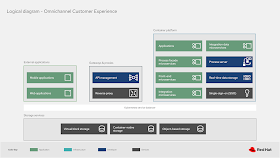 |
| Part 2 - Common architectural elements. |
The process was laid out how I've approached the use case and how I've used successful customer portfolio solutions as the basis for researching a generic architecture. The only thing left to cover was the order in which you'll be led through the architectural details.
This article starts the real journey at the very top, with a generic architecture from which we'll discuss the common architectural elements one by one.
From specific to generic
Before diving in to the common elements, it might be nice to understand that this is not a catch all for every possible integration solution. It's a collection of identified elements that I've uncovered in multiple, from two to three, customer implementations. These elements presented here are then the generic common architectural elements that I've identified and collected in to the generic architecture.
It's my intent to provide an architecture that provides guidance and not deep technical details. You're smart enough to figure out wiring integration points in your own architectures. You're capable of slotting in the technologies and components you've committed to in the past where applicable. It's my job here to describe the architectural generic components and outline a few specific cases with visual diagrams so that you're able to make the right decisions from the start of your integration projects.
Another challenge has been how to visually represent the architecture. There are many ways to represent each element, but I've chosen some icons, text and colours that I hope are going to make it all easy to absorb. Feel free to post comments at the bottom of this post, or contact me directly with your feedback.
 |
| Common architectural elements for external applications. |
External applications
Starting at the top of the diagram, which is by no means a geographical necessity, there are two elements that represent external applications that interact with the architecture. Distilling the various applications discovered in customer solution research, I've come up with two common representations.
The first is mobile applications, covering basically everything that customers use to interact directly with a company. This can be mobile applications deployed by the company themselves or developed by third party organizations to interact with the services offered.
The second is web applications, a broad element to contain all other types of applications, web sites and/or services that are deployed by the company or any third party organizations to interact with the services offered.
The first is mobile applications, covering basically everything that customers use to interact directly with a company. This can be mobile applications deployed by the company themselves or developed by third party organizations to interact with the services offered.
The second is web applications, a broad element to contain all other types of applications, web sites and/or services that are deployed by the company or any third party organizations to interact with the services offered.
 |
| Common architectural elements are API's and proxies. |
API gateway & proxy
The proxy shown was a reverse proxy, a standard solution for providing a security layer between external applications calling internal services by hiding the internal addresses.
Container platform
Without a doubt, every organization engaged in omnichannel integrations to improve customer experience has seen the value of containers and use of a container platform. The container platform provides for one consistent environment for developers and operations to manage services, applications, integration points, process integration, and security.
It's also the one way to ensure you can uniformly leverage the same container infrastructure across a hybrid multicloud environment. It avoids becoming locked into any private or cloud infrastructure as you have an exit strategy with a container platform that's consistent across your architecture.
The security aspect is interwoven in the container platform, as each container service, application, or process integration can be plugged in to an organizations authentication and authorization mechanisms.
 |
| Common architectural element is a container platform. |
The security aspect is interwoven in the container platform, as each container service, application, or process integration can be plugged in to an organizations authentication and authorization mechanisms.
Storage services
| Common architectural elements in storage services. |
In later articles, when more detail is shown, I'll make a point to present a few of the options chosen by customers integrating data services with processes and applications.
What's next
This was just a short overview of the common generic elements that make up our architecture for omnichannel customer experience use case.
An overview of the series on omnichannel customer experience portfolio architecture can be found here:
Catch up on any articles you missed by following one of the links above.
Catch up on any articles you missed by following one of the links above.
Next in this series, taking a look at the details of external applications in an architecture for omnichannel customer experience.